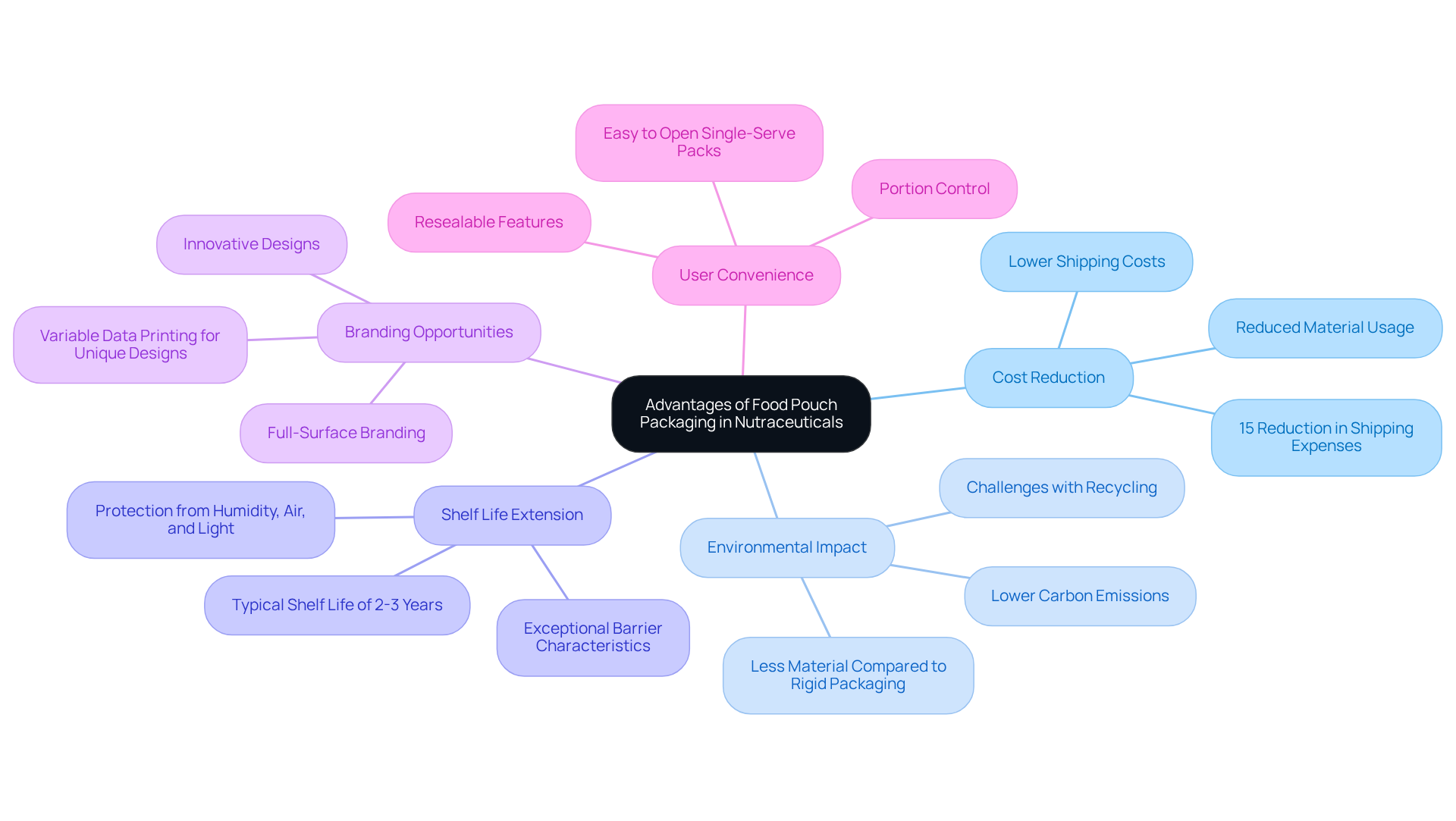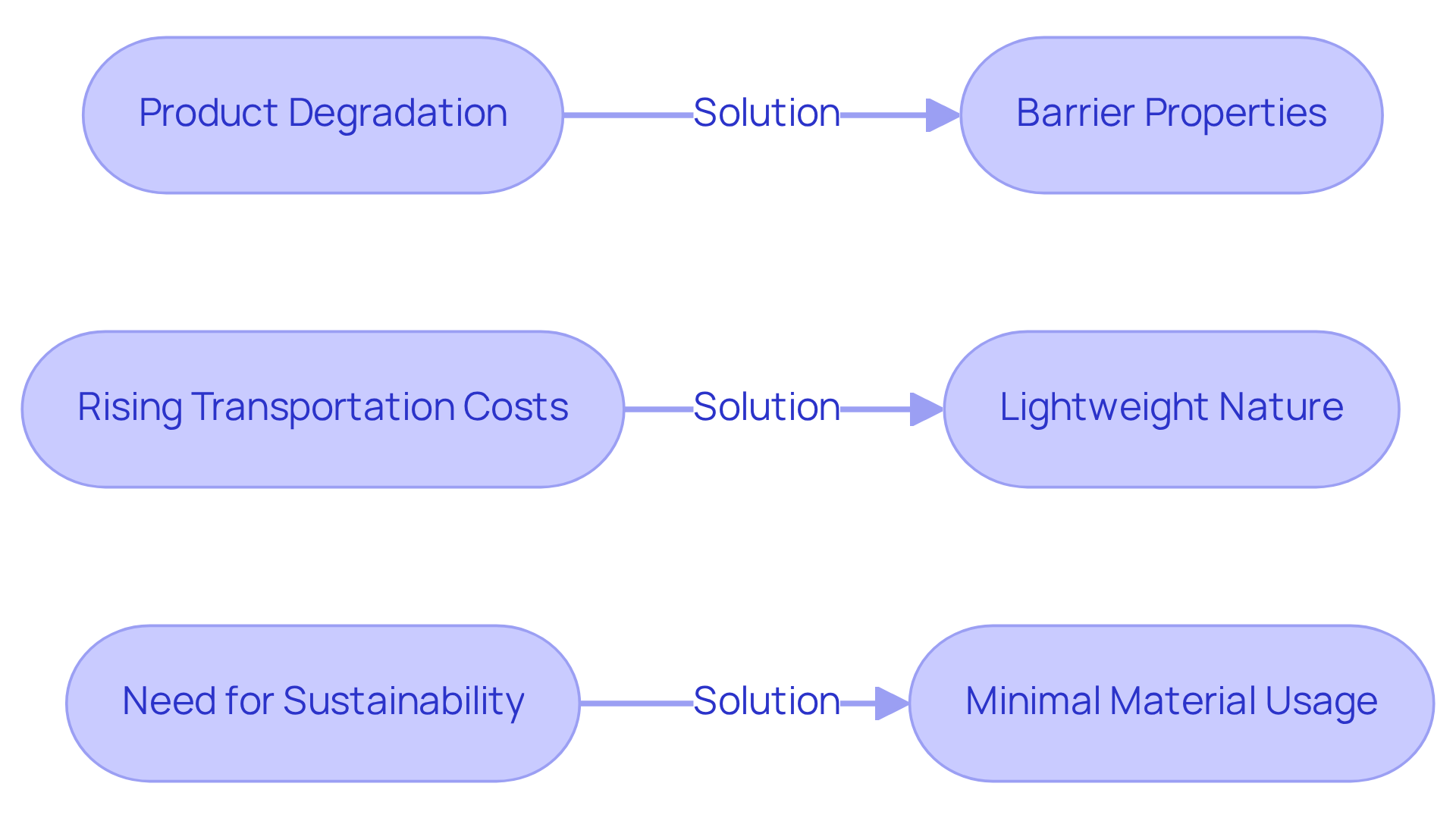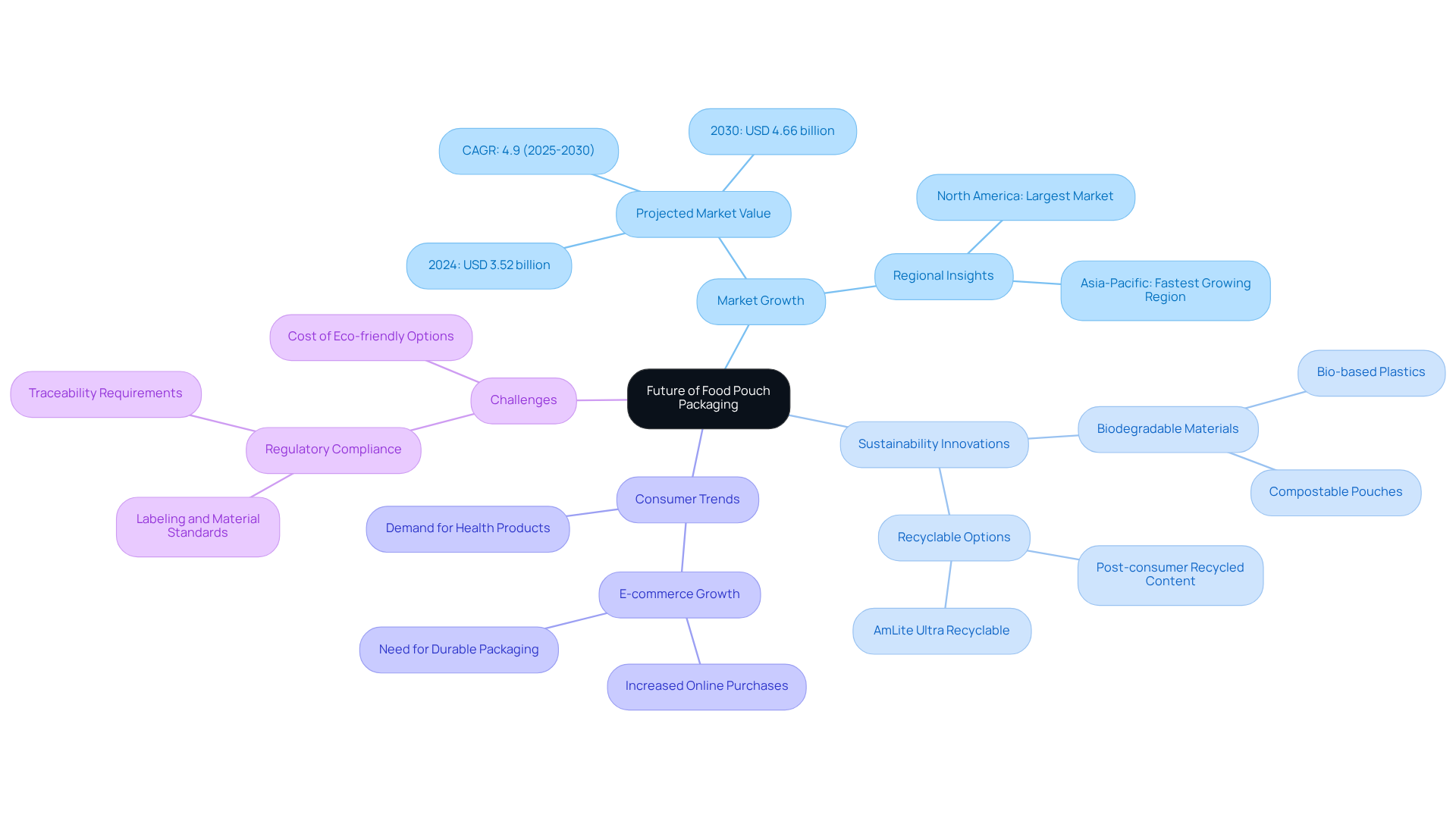Overview
Food pouch packaging is transforming the nutraceuticals industry by providing convenience, portability, and sustainability—key factors that resonate with the evolving preferences of health-conscious consumers. This shift is underpinned by significant advancements in packaging technology, which not only enhance product integrity and shelf appeal but also address critical industry challenges such as rising transportation costs and the pressing need for eco-friendly solutions.
As the demand for innovative packaging continues to grow, it is imperative for industry stakeholders to embrace these developments to remain competitive and responsive to consumer needs.
Introduction
The nutraceutical industry is experiencing a significant transformation, driven by a shift in consumer preferences towards more convenient and sustainable packaging solutions. Food pouch packaging has emerged as a frontrunner in this evolution, appealing to health-conscious individuals who seek portable and eco-friendly options.
As brands adapt to these changing demands, they face the challenge of balancing innovation with regulatory compliance. This raises an important question: what makes food pouch packaging not just a trend, but a pivotal element in the future of nutraceuticals?
Transforming Nutraceuticals: The Shift to Food Pouch Packaging
The nutraceutical industry is witnessing a significant transformation in packaging preferences, with food pouch packaging becoming a leading choice. This shift is driven by an increasing public demand for convenience, portability, and sustainability. As health-conscious consumers seek offerings that align with their lifestyles, brands are adapting to these evolving preferences. Food containers, such as large bags for protein products and stick packs for nutraceuticals, provide a lightweight, compact alternative to traditional rigid containers, making them ideal for on-the-go use. Moreover, advancements in container technology have enabled producers to create pouches that not only preserve product integrity but also enhance shelf appeal.
This evolution reflects a broader trend towards flexible packaging solutions that meet contemporary consumer needs, fundamentally transforming how nutraceuticals are presented and utilized. Industry leaders emphasize that adaptable packaging not only caters to the demands of health-aware individuals but also supports sustainability initiatives, positioning it as a strategic choice for brands aiming to enhance market visibility. Notably, leading brands have successfully adopted food pouch packaging for health products, demonstrating its effectiveness in appealing to consumers who prioritize convenience and eco-friendliness.
Statistics reveal that a significant proportion of consumers now prefer flexible containers for nutraceuticals, underscoring the importance of this trend in shaping the industry's future. The global nutraceutical container market was valued at approximately USD 5.05 billion in 2024 and is projected to reach around USD 5.30 billion in 2025, highlighting the growing significance of flexible packaging solutions. Furthermore, with 74% of U.S. adults reporting the use of dietary supplements, the relevance of adaptable containers in meeting the needs of a health-conscious consumer base is further emphasized. However, regulatory compliance remains a challenge for stakeholders in containerization, making it essential for manufacturers to incorporate these considerations into their strategic planning.

Advantages of Food Pouch Packaging in Nutraceuticals
Food container design presents a multitude of benefits tailored specifically for nutraceutical items. Among these, the lightweight nature of these containers stands out, significantly reducing shipping costs while minimizing carbon emissions during transportation. This aspect is particularly crucial, given that the global supplements and nutrition packaging market was valued at $20.52 billion in 2020 and is projected to grow to $26.93 billion by 2026, underscoring the increasing demand for efficient packaging solutions. Furthermore, these containers exhibit exceptional barrier characteristics, safeguarding sensitive components from humidity, air, and light, thereby extending shelf life and preserving product efficacy for the typical duration of 2-3 years that most supplements require.
The versatility of bag designs opens the door to innovative branding opportunities, empowering companies to differentiate themselves in a competitive landscape. Resealable features enhance user convenience, catering to consumers who prioritize portion control—an increasingly vital consideration in today's health-conscious market. Industry experts emphasize that adopting lightweight containers not only leads to cost savings but also aligns with sustainability goals, as flexible bags necessitate significantly less material compared to rigid plastic or glass bottles.
Numerous nutraceutical companies have successfully reduced shipping costs by transitioning to bag containers, illustrating their effectiveness in optimizing supply chains. A notable case study highlights a leading supplement brand that experienced a 15% reduction in shipping expenses after adopting flexible packaging. Collectively, these advantages contribute to a more streamlined supply chain and an improved consumer experience, reinforcing the position of food sachets as a groundbreaking solution within the nutraceutical sector.

Addressing Industry Challenges: How Food Pouch Packaging Provides Solutions
The nutraceutical sector confronts significant challenges, including the degradation of goods, rising transportation costs, and an urgent need for sustainable practices. Food pouch packaging offers a robust solution to these issues. With exceptional barrier properties, bags effectively shield products from environmental factors that can compromise quality, ensuring that active components remain potent and effective. This is particularly critical for sensitive nutraceuticals, where preserving product integrity is of utmost importance.
Moreover, the lightweight nature of bags leads to reduced shipping costs, rendering them a cost-effective choice for producers. As sustainability gains traction among consumers, the minimal material usage in flexible containers aligns perfectly with eco-friendly initiatives, appealing to environmentally conscious buyers. Notably, companies like Amcor and Constantia Flexibles have successfully employed flexible containers to enhance product integrity while adhering to sustainable practices. By addressing these industry challenges, food pouch packaging solutions not only elevate product quality but also support the nutraceutical sector's transition toward more sustainable alternatives.

Future Implications: Sustainability and Market Trends in Food Pouch Packaging
Looking ahead, the trend towards food bag solutions in the nutraceutical sector is poised for significant expansion, driven by increasing consumer demand for sustainable and convenient options. The nutraceutical container market is projected to grow from USD 3.52 billion in 2024 to USD 4.66 billion by 2030, reflecting a compound annual growth rate (CAGR) of 4.9% during the period from 2025 to 2030.
As brands endeavor to minimize their environmental impact, innovations in biodegradable and recyclable materials, such as bio-based plastics and compostable pouches, are expected to gain momentum. Moreover, the rise of e-commerce and direct-to-consumer sales will further propel the acceptance of adaptable solutions that enhance product visibility and appeal.
Companies that embrace these trends will not only fulfill consumer expectations but also establish themselves as leaders in sustainability within the nutraceutical market. However, challenges remain, including the higher costs associated with eco-friendly options and the necessity for regulatory compliance regarding materials.
The future of food pouch packaging looks promising, as it has the potential to transform the packaging, marketing, and consumption of nutraceuticals.

Conclusion
The shift towards food pouch packaging is revolutionizing the nutraceutical industry, offering innovative solutions that cater to modern consumer demands for convenience, sustainability, and product integrity. This transformative approach not only enhances the user experience but also aligns with the industry's broader goals of reducing environmental impact and optimizing supply chains.
Key insights from the article highlight the advantages of food pouch packaging, including:
- Its lightweight nature
- Exceptional barrier properties
- Versatility in design
These features not only help in preserving the efficacy of nutraceuticals but also contribute to significant cost savings in shipping and production. Moreover, as brands increasingly adopt these flexible solutions, they position themselves favorably in a competitive market that prioritizes eco-friendly practices.
Looking ahead, the future of food pouch packaging in the nutraceutical sector appears bright, driven by growing consumer expectations for sustainable and efficient options. Companies that embrace these trends will not only meet market demands but also set the standard for sustainability within the industry. As the nutraceutical landscape continues to evolve, the adoption of innovative packaging solutions will play a crucial role in shaping a healthier and more environmentally conscious future.
Frequently Asked Questions
What is driving the shift to food pouch packaging in the nutraceutical industry?
The shift is driven by increasing public demand for convenience, portability, and sustainability as health-conscious consumers seek offerings that align with their lifestyles.
What are the advantages of food pouch packaging compared to traditional rigid containers?
Food pouch packaging offers a lightweight, compact alternative that is ideal for on-the-go use, preserving product integrity while enhancing shelf appeal.
How does food pouch packaging support sustainability initiatives?
Adaptable packaging caters to the demands of health-aware individuals and supports sustainability initiatives, making it a strategic choice for brands looking to enhance market visibility.
What statistics highlight the trend towards flexible packaging in the nutraceutical industry?
A significant proportion of consumers now prefer flexible containers for nutraceuticals, and the global nutraceutical container market was valued at approximately USD 5.05 billion in 2024, projected to reach around USD 5.30 billion in 2025.
How prevalent is the use of dietary supplements among U.S. adults?
Approximately 74% of U.S. adults report the use of dietary supplements, emphasizing the relevance of adaptable containers in meeting the needs of a health-conscious consumer base.
What challenges do manufacturers face regarding packaging compliance?
Regulatory compliance remains a challenge for stakeholders in containerization, making it essential for manufacturers to incorporate these considerations into their strategic planning.




